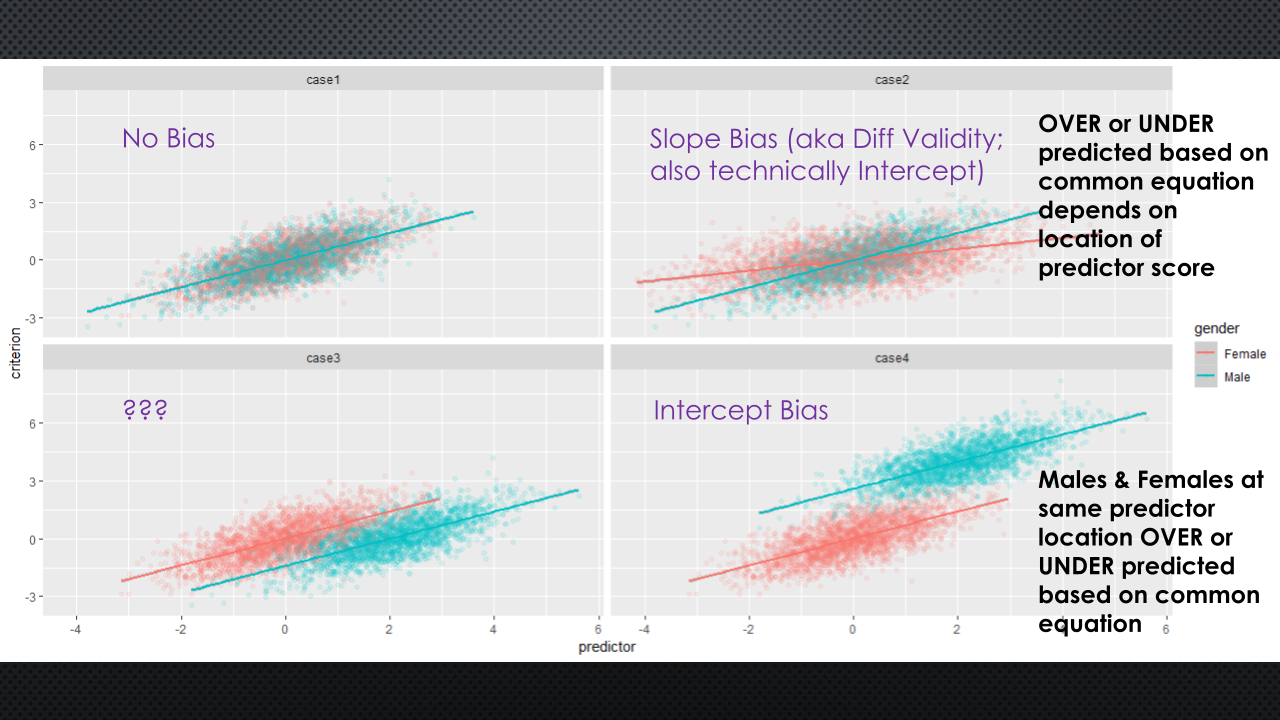Ψlogical
Testing
Test Bias
House Keeping
Lectures:
- Alpacas present
Tuesday!! 🦙- schedule available here
- rubric available here
- expect more lab/lecture overspill
- Final on 5/23 (merely Exam #3)

![]()
🔭🌠ASTEROID YR4 PANIC METER!!!🌌💥



Test Bias

Context
The most difficult problem is that some ethnic groups obtain lower average scores on some psychological tests. The most controversial case concerns intelligence tests (Kaplan & Saccuzzo, 2018, p. 514)


“Controversial” Question…
…are these observed (e.g., “X”) differences reflective of true scores (e.g., “T”) or are they indicating systematic error within the test scores?
- systematic error can arise from contamination
- stereotype threat is another potential source of systematic error
Note
It’s important to note that, even though group differences are observed, individuals from different groups do attain scores all along the possible score continuua for these “g”–loaded tests.
Traditional Defense of Testing (I)
content–related evidence for validity:
- are items that populate these tests “problematic” for some individuals with a shared group membership?
- possible that children haven’t had opportunity to learn content
- vocabulary & idioms
- Black Intelligence Test of Cultural Homogeneity (Williams, 1972) a tongue–in–cheek attempt to demonstrate culturally–embedded (e.g., problematic) content
- example of 5 BITCH items
Traditional Defense of Testing (II)
Differential Item Functioning:
- statistical procedure that compares item characteristic curves from separate groups
- equal abilities (X–axis) should have equal probabilities of correct item response (Y–axis)

“Criterion–related” sources of bias (I)
Search for bias here is focused on the relationship between test scores (aggregate scale score) and some criterion of interest (e.g., DV)
- uses statistical procedure (regression1) to explore different associations between IV (test score) and DV (outcome)

“Criterion–related” sources of bias (II)
- focus traditionally placed on 2 regression coefficients
- test bias here is synonymous with differential validity
- different regression line slopes for each group1

Other approaches to testing
Some Ψs unsatisfied with lack of DIF and differential validity as defense for using tests that exhibit group differences…
- one explanation for group differences is lack of exposure to content (e.g., “ignorance”)
- if true, differences should be manipulable (flip \(\pm\) or obviate differences)
- Chitlin Test (Dove, 1968)
- BITCH (Williams, 1972)
- System of Multicultural Pluralistic Assessment1 (Mercer & Lewis, 1977)
- Battery of medical, social, & pluralistic
Ethical models of bias
…three mutually incompatible ethical positions in regard to the fair and unbiased use of psychological tests… (Hunter & Schmidt, 1976, p. 1053)
- unqualified individualism – use any information that helps find the best candidates for a job or school
- quotas – placement outcomes should be proportional to population constituency
- qualified individualism – an ethical imperative exists to ignore group identification (not treat differently)
Statistical models of test bias…
…usually utilize regression procedures – all of which align with the fairness philosophies of Hunter & Schmidt (1976)
General consensus is that, “no bias exists if the regression equations relating the test and the criterion are indistinguishable for the groups in question” (American Educational Research Association et al., 2014, p. 79)
Warning
The textbook’s presentation of Test Fairness Models (pp. 533–535) is out–of–date and in violation of the Civil Rights Act of 1991

Tests can harm?
Tests ideally provide greater insight into individuals, helping them build better and more productive lives (identify strengths & weaknesses and inform action plans)… however, the ideal isn’t always met:
- potentially reinforce stereotypes or negative self–beliefs (e.g., “I’m not good at math”)
- speculation that this could contribute to a fixed mindset (e.g., Dweck & Yeager, 2019)
- growth mindset generally considered more beneficial for academic performance

According to the textbook, the most controversial test differences occur with ___________
- intelligence
- personality
- interest
- psychopathology
The statistical procedure that compares item characteristic curves is known as ___________
- differential item functioning
- prenatal toe grabbing
- differing discrimination indices
- moderated hierarchical regression
The statistical procedure most often leveraged to probe for test bias is ___________
- regression
- correlation
- ANOVA
- t–test
When seeking criterion–related validity, the criterion is the methodological _______
- dependent variable
- independent variable
- moderator
- mediator
Which of the following IS NOT one of the 3 discussed ethical models of bias?
- unified collectivism
- quotas
- unqualified individualism
- qualified individualism
Assessment groups:
| Dingos🦊 | Camels🐫 | Alpacas🦙 | Belugas🐳 | Elephants🐘 |
|---|---|---|---|---|
| Sarah M | Sarah J | Vanessa A | Mae F | Hannah T |
| Raelyn R | Thomas J | Sabina B | Alaina G | William T |
| Ellen R | Grace K | Nathan B | Payton H | Jennifer T |
| Rachel S | Grace L | Maritza B | Elly J | Lila W |
| 4/29 | 5/1 | 5/6 | 5/8 | 5/13 |
